An industrial boiler is a complex system that generates steam or hot water for various industrial processes or heating applications. Do you know how does an industrial boiler work?
How Does an Industrial Boiler Work
Here’s a simplified overview of how it works:
Fuel Input
Industrial boilers are vital components in various industries, producing steam or hot water for many processes and applications. They operate through intricate steps, with fuel input as a crucial starting point. The most prevalent fuels utilized in these boilers include natural gas, oil, coal, biomass, and electricity. These fuels are introduced into the boiler system through burners or stokers, facilitating controlled combustion.
Once the fuel is introduced, the combustion process occurs within a designated chamber, wherein fuel mixes with air and ignites, releasing heat energy. The design of this combustion chamber can vary depending on the type of boiler, encompassing configurations like fire-tube, water-tube, or fluidized bed. The resulting heat from combustion is then transferred to water contained within the boiler, facilitated by tubes or passages where hot gases flow, heating the surrounding water.
Furthermore, this heat exchange process generates steam or hot water, depending on the boiler type. Water is converted into steam in water-tube boilers as it traverses tubes surrounded by hot combustion gases. Conversely, fire-tube boilers have hot gases pass through tubes immersed in water to generate steam. The generated steam is subsequently directed to different parts of the industrial process or for other applications, while hot water is pumped to areas requiring heating or other uses.
Control System
Control systems play a critical role in managing the operation of industrial boilers, regulating fuel input, airflow, and water levels to optimize efficiency and ensure safe operation. These systems can range from manual operation to highly automated setups. Furthermore, modern boilers incorporate emissions control mechanisms to reduce pollutants like nitrogen oxides (NOx), sulfur dioxide (SO2), and particulate matter, employing technologies such as scrubbers and filters.
Furthermore, maintenance and safety are paramount when operating industrial boilers. Regular maintenance, including cleaning, inspection, and repair of components, is essential for safe and efficient operation. Safety measures such as pressure relief valves, water level gauges, and alarms are implemented to prevent accidents and ensure the boiler operates within safe parameters.
Combustion Chamber
Combustion chambers are pivotal spaces within industrial boilers where fuel undergoes controlled burning. Here, fuel blends with air, igniting and releasing heat energy. The design of these chambers varies, with configurations like fire tube, water tube, or fluidized bed contingent upon boiler design.
In fire-tube boilers, combustion happens within tubes surrounded by water, whereas water-tube boilers feature tubes through which water flows, surrounded by hot gases. Fluidized bed boilers use a bed of solid particles suspended in a stream of air for combustion.
Furthermore, this combustion process initiates the transfer of heat energy to water, leading to steam or hot water generation. It’s a critical step in the boiler operation, influencing efficiency and emissions. Engineers optimize designs for better performance and environmental impact by understanding combustion chamber dynamics.
Heat Exchange
Heat exchange is fundamental in industrial boilers: heat generated from combustion transfers to water within the boiler. This transfer primarily occurs through tubes or passages where hot gases flow, heating the surrounding water.
Water within the boiler absorbs heat as it passes through these channels, transforming into steam or hot water. This process is vital for various industrial operations, from powering turbines to heating buildings.
Efficiency in heat exchange is critical for optimal boiler performance. Engineers meticulously design these systems, considering tube arrangement, material, and fluid dynamics to maximize heat transfer.
Understanding heat exchange mechanisms is crucial for maintaining efficiency and controlling emissions. By improving heat transfer efficiency, industries reduce energy consumption and environmental impact, advancing towards more sustainable practices.
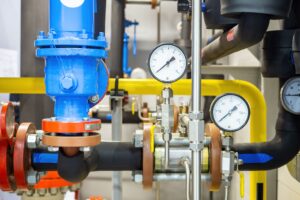
Steam or Hot Water Generation
In industrial boilers, heated water transforms into steam or hot water, which serves various industrial processes. Water-tube boilers achieve this by passing water through tubes surrounded by hot combustion gases, converting water into steam. Conversely, fire-tube boilers have hot gases pass through tubes immersed in water to generate steam.
Water circulates through the tubes in water-tube boilers, absorbing heat from the combustion gases surrounding them. This heated water then exits the boiler as steam. Fire-tube boilers work oppositely; hot gases flow through the tubes, transferring heat to the surrounding water. As water absorbs heat, it boils, producing steam within the boiler.
The choice between water-tube and fire-tube boilers depends on application, space constraints, and efficiency requirements. Water-tube boilers offer faster steam production and better response to load changes, while fire-tube boilers are more straightforward in design and often used for smaller applications. Understanding these distinctions aids engineers in selecting the most suitable boiler type for specific industrial needs.
Steam Distribution
In industrial processes where steam boilers are employed, the generated steam is a versatile energy carrier distributed to various parts of the operation. Steam distribution is crucial, as it impacts the efficiency and effectiveness of numerous industrial applications.
Steam produced in boilers is directed to different parts of the industrial process, performing various functions. One of the primary uses of steam is for heating. In many industries, steam is utilized to heat buildings, facilities, or process equipment. For example, steam can be circulated through radiators or heat exchangers to provide building warmth or maintain specific temperatures in manufacturing processes.
Power Generation
Furthermore, steam is frequently employed for power generation. In steam turbines, high-pressure steam from boilers turns blades, generating mechanical energy that can be converted into electrical power. This process is standard in power plants, where steam drives turbines connected to electrical generators, producing electricity for various industrial and commercial needs.
Steam also finds application in processes requiring high temperatures or pressure. Industries such as chemical, food processing, and pharmaceuticals use steam for sterilization, cleaning, and cooking due to its ability to deliver heat uniformly and rapidly. Steam is also utilized in textile manufacturing for dyeing and finishing processes.
Steam distribution involves a network of pipes, valves, and controls to regulate flow and pressure. Steam distribution systems must be carefully designed to minimize energy losses and ensure efficient delivery to the required destinations. Additionally, safety measures such as pressure relief valves and steam traps are installed to maintain safe operating conditions and prevent damage to equipment.
Understanding steam distribution’s diverse applications and requirements is essential for optimizing industrial processes. Engineers and operators must consider steam pressure, temperature, flow rates, and quality to ensure steam’s effective and safe utilization in various industrial applications. Efficient steam distribution contributes to energy savings, increased productivity, and enhanced operational reliability in industrial facilities.
Condensation
After steam completes its tasks in steam boilers, it can be condensed back into water for reuse. This condensed water is often returned to the boiler for heating. The process of condensation is crucial for several reasons.
Firstly, condensing steam back into water releases the latent heat it contains, which can be recovered and reused, enhancing the boiler system’s overall efficiency. Additionally, reusing condensed water reduces water consumption, making the process more environmentally friendly and cost-effective.
Condensate recovery systems collect and treat condensed water, removing impurities and maintaining water quality. Proper treatment ensures that the returned water does not adversely affect boiler performance or cause corrosion.
By incorporating condensation into the boiler system, industries can achieve significant energy savings and improve sustainability while ensuring reliable operation and reducing water usage. Understanding and optimizing condensation processes are vital for maximizing the efficiency and effectiveness of steam boiler systems in various industrial applications.
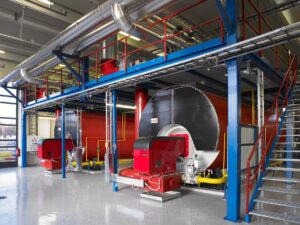
Hot Water Distribution
Hot water boilers are pumped where needed to heat buildings and provide hot water for various processes or other purposes.
Control Systems
Modern industrial boilers feature advanced control systems to manage fuel input, airflow, and water levels to optimize efficiency and safety. These control systems can be either manual or automated, depending on the boiler’s complexity and the specific requirements of the industrial process.
Manual control systems rely on operators to adjust parameters such as fuel flow rates, air intake, and water levels based on monitoring equipment readings and operational experience. While manual systems are more straightforward and less costly, they require continuous attention and expertise from operators to maintain optimal performance.
On the other hand, automated control systems use sensors and feedback mechanisms to monitor boiler conditions and adjust settings automatically. These systems offer greater precision and efficiency by continuously optimizing operations based on real-time data. They also provide features like remote monitoring and diagnostics, enhancing safety and reducing the need for constant manual intervention.
Effective control systems are essential for maintaining stable and efficient boiler operation regardless of the type. They ensure that the boiler operates within safe limits, prevents malfunctions, and maximizes energy efficiency, contributing to cost savings and environmental sustainability in industrial processes.
Emissions Control
Industrial boilers frequently integrate emissions control systems to mitigate nitrogen oxides (NOx), sulfur dioxide (SO2), and particulate matter. These systems employ various technologies, such as scrubbers, filters, and catalytic converters, to reduce pollution.
Scrubbers utilize chemical reactions to remove harmful gases from boiler emissions. Wet scrubbers, for instance, use water or other liquid solutions to capture pollutants through absorption or chemical reactions. Dry scrubbers utilize alkaline sorbents to neutralize acidic gases.
Filters, including electrostatic precipitators and baghouses, trap particulate matter from flue gases. Electrostatic precipitators use electric charges to attract and collect particles, while baghouses capture particles on fabric filters.
Catalytic converters facilitate chemical reactions to convert harmful gases into less toxic substances. For example, selective catalytic reduction (SCR) systems use catalysts to convert NOx into nitrogen and water.
These emissions control technologies play a crucial role in reducing the environmental impact of industrial boilers, ensuring compliance with emissions regulations, and promoting cleaner air quality. Effective implementation of these systems contributes to sustainable industrial practices and environmental protection.
Maintenance and Safety
Regular maintenance and safety measures are critical to ensuring industrial boilers’ safe and efficient operation. These boilers are complex systems that require careful attention to ensure they function reliably while minimizing risks to personnel and the environment.
Furthermore, industrial boiler maintenance encompasses various tasks to keep the system in optimal condition. One of the primary maintenance activities is cleaning, which involves removing deposits and debris from multiple components. Over time, boilers can accumulate scale, corrosion, and other contaminants, reducing efficiency and leading to equipment failure.
Cleaning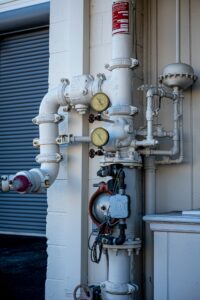
Cleaning methods may include chemical cleaning, water flushing, or mechanical methods such as brushing or scraping.
Regular Inspection
In addition to cleaning, regular inspection of boiler components is essential for identifying potential issues before they escalate. Inspections can reveal wear and tear, corrosion, or leaks in boiler tubes, fittings, and valves. By detecting problems early, maintenance personnel can take corrective action to prevent costly breakdowns or safety hazards.
Repairing
Another crucial aspect of boiler maintenance is repairing and replacing worn or damaged components. This may involve repairing leaks, replacing damaged tubes, or refurbishing valves and fittings. Timely repairs help maintain the boiler system’s integrity and ensure it continues to operate safely and efficiently.
Safety measures are paramount in industrial boiler operations to prevent accidents and protect personnel and equipment. Pressure relief valves are critical safety devices that release excess pressure in the boiler to avoid over-pressurization and potential explosions. These valves must be regularly inspected and tested to ensure they function correctly.
Water Level Gauges
Water level gauges are another essential safety feature in boilers. These devices monitor the water level inside the boiler and indicate whether it is too high or too low. Maintaining the correct water level is crucial for preventing damage to boiler components and ensuring efficient steam generation.
Alarms and Shutdown System
Furthermore, alarms and shutdown systems are implemented to provide early warning of potential hazards and to shut down the boiler if unsafe conditions are detected automatically. For example, high-pressure alarms alert operators to dangerous pressure levels, while flame failure detectors shut down the boiler if the flame goes out unexpectedly.
Personal Training
Personnel training and education are also vital aspects of boiler safety. Operators and maintenance personnel must be adequately trained in boiler operation, maintenance, and emergency procedures. They should understand the risks associated with boiler operation and be familiar with safety protocols to mitigate them.
Regular maintenance and robust safety measures are essential for industrial boilers’ safe and efficient operation. By adhering to strict maintenance schedules, conducting thorough inspections, and implementing appropriate safety measures, industries can minimize downtime, reduce the risk of accidents, and ensure the longevity of their boiler systems.
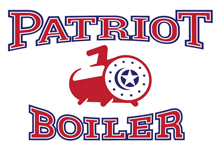
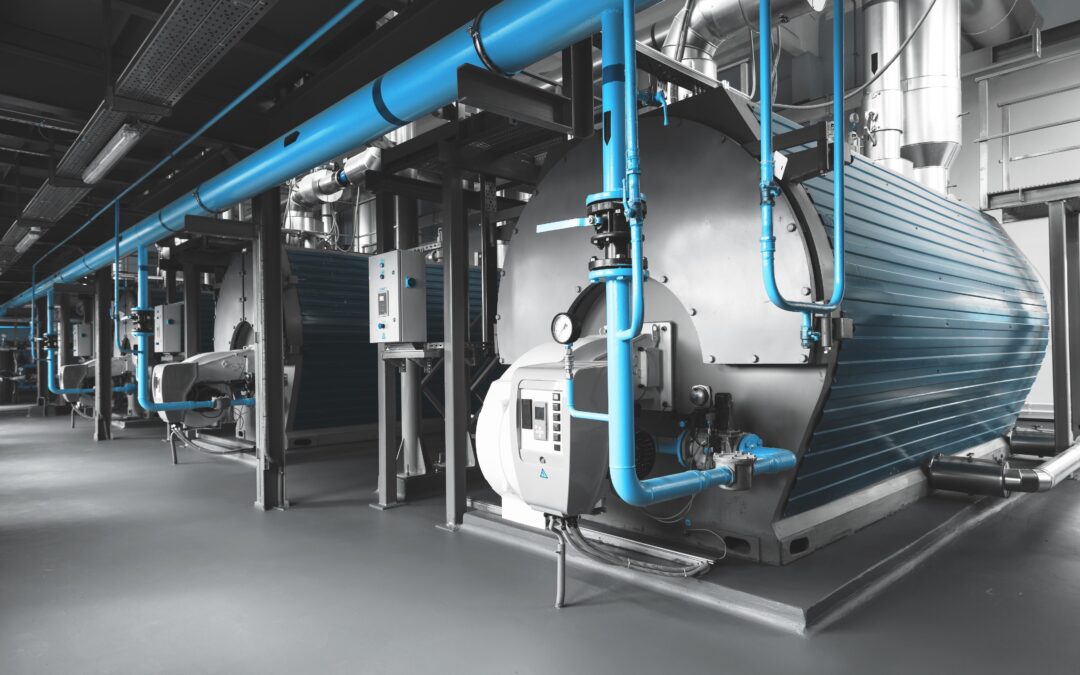
Recent Comments